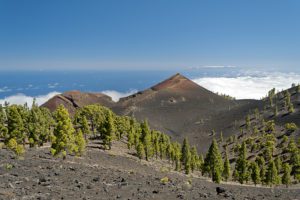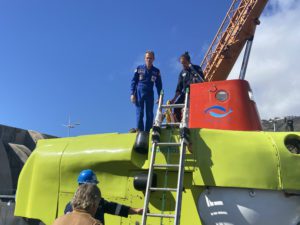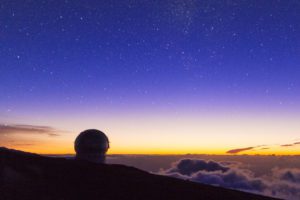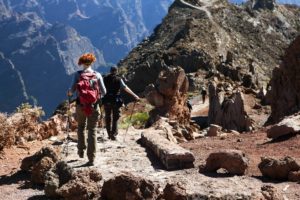La Palma lava delta seabed recovers in record time
The unique environmental conditions of the waters surrounding the Canary Isalnds is allowing the lava delta seabed in La Palma to recover in record time from a recent eruption of the Cumbre Vieja volcano according to IEO-CSIC researcher Eugenio Fraile
The environmental conditions of the waters of the Canary Islands help the recovery and recolonization of its volcanic seabed at rapid speeds. Proof of this can be seen at the bottom of the La Palma lava delta, which in less than a year after an eruption is coming back to life. The waters of the Canary Islands have helped in the recolonization of the rock formations formed after the eruption of the Cumbre Vieja volcano, a rich geological heritage site unique to the Canary Islands. These are findings that have been verified by the Spanish Institute of Oceanography (IEO), a subsidiary of the Spanish National Research Council (CSIC), which together with Canary Islands Tourism carried out an ambitious scientific expedition aboard a manned submarine for the first time.
The Pisces VI, one of the five manned submarines in the world that can break the 2,000-meter depth barrier, has explored and documented the new marine habitats created by the Cumbre Vieja volcano, with the aim of highlighting the unique geological heritage of the lava delta on the island of La Palma and its possible economic benefits. “The lava flow that came into contact with the sea significantly damaged the marine ecosystem of the area, but now, only a year later, the magnificent environmental properties of the waters of the Canary Islands have ensured that these new rock formations created under the sea of the Canary Islands have already begun to take on life. This is surprising. So we can confirm that the ocean of the Canary Islands has the capacity to show signs of recolonization in a marine ecosystem in less than a year,” says Eugenio Fraile, scientific researcher at the IEO-CSIC.
Geological heritage
The Canary Islands are a unique archipelago in an exceptional location for oceanographic studies. Additionally, the extension of the island of La Palma has actually increased since the eruption. “Few regions can say that their territory has grown in recent years. And La Palma is one of them. The new lava delta that has been created on the island of La Palma is one of the youngest volcanic formations in the world. In addition, in the La Palma lava delta we have found large extensions of mega pillow lavas, unusual lava formations that are easily accessible to tourists”, says the oceanographer.
Pisces VI, quality technology for observing the deep oceans
The expedition aboard the Pisces VI to explore the lava deltas created during the eruption has been able to document both before and after the eruption. “This is a scientific and technological milestone, as there are only five submarines with these characteristics in four countries in the world,” Fraile says. The Canary Islands have thus joined an exclusive list of territories – the United States (2), Japan (1), China (1) and France (1) – that have been able to explore the deep oceans first hand.
To carry out this research, for the first time in Spain with a manned submarine, the IEO-CSIC partnered with 7 other research institutions: Geological and Mining Institute of Spain (IGME-CSIC), National Geographic Institute (IGN), Institute of Natural Products and Agrobiology (IPNA-CSIC), General Secretariat of Fisheries, the University of Las Palmas de Gran Canaria (ULPGC) and the University from La Laguna (ULL). As well as the Pisces VI, the expedition used the most advanced technology, through the oceanographic vessel Ramón Margalef and the underwater robot Liropus 2000, both from the IEO-CSIC. The results of the research by the Spanish Institute of Oceanography (IEO-CSIC) will be completed within a year.
La Palma, la Isla Bonita
On La Palma, one of the eight Canary Islands, heaven has a special meaning. The Starlight Reserve is one of the best places in the world for stargazing. A gift from heaven that the inhabitants of this little island, just a four-hour flight from central Europe, know how to cherish: a legislation drafted in 1988 protects the reserve from light pollution, invasive air traffic and guarantees everyone’s right to enjoy it.
And if we dive into the water? Breathtaking. The island has one of three marine reserves in the Canary Islands: an underwater volcanic landscape that is astoundingly beautiful and full of caves, arches and walls, as well as being home to many species, some of which are unique to the area. Also surroudning La Palma’s coastline are many beautiful natural pools where you can sit and relax in. They are protected from the waves by lava flows that reached all the way down to the sea. Or you can enjoy visiting La Caldera de Taburiente National Park, one of the most spectacular natural spaces in the Canary Islands and, without a doubt, La Palma’s greatest treasure.
Best of all? You can enjoy this incredible island, which is a biosphere reserve, any day of the year. That’s the advantage of being one of the Canary Islands and being blessed with the best climate in the world.




